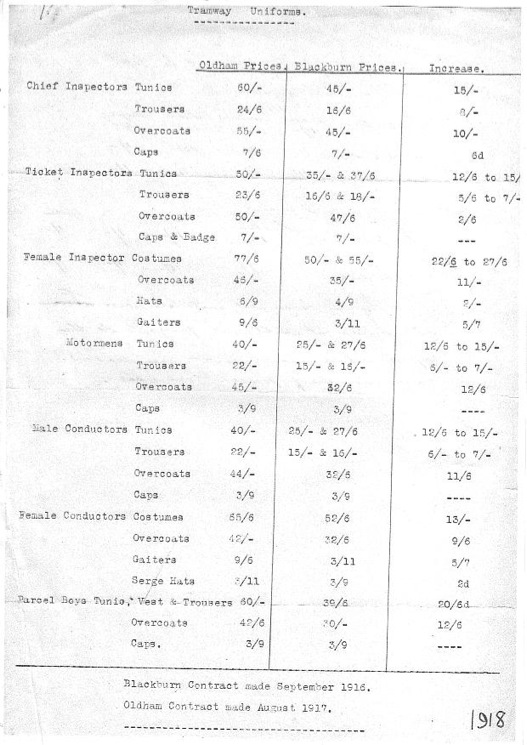Blackburn Corporation Tramways
History
Although Blackburn Corporation became a tramway owner in the late 1880s, it did not actually work the services itself, instead leasing them to the Blackburn Corporation Tramways Company Ltd, which despite the title, was a completely separate entity.
The BCTCo was first and foremost a steam-tram operator, with the first steam-operated services commencing on the 28th May 1887. From the 25th August 1888 however, horse traction was introduced on some lines; this seemingly regressive step was taken at the insistence of the corporation, who did not want steam traction used on certain lines, despite the fact that it made these services unremunerative. By the end of the following decade, and after a good deal of acrimony between the corporation and the company, the corporation acquired the BCTCo (on the 24th August 1898) as well as a share of another steam tramway — owned by the Blackburn and Over Darwen Tramways Company — that plied between Blackburn and Darwen (Whitehall). The B&ODTCo was purchased by Blackburn and Darwen Corporations on the 1st January 1899, based on the proportion of track in each of the municipalities, but with Blackburn agreeing to continue running the steam services in Darwen under a lease agreement.
The acquisition of the two steam tramways was a necessary step in establishing Blackburn's vision of a municipally owned and operated electric tramway system, something that would take it the best part of three years to achieve. Its desire to fulfill this vision undoubtedly led to it paying a premium for the BCTCo, which still had ten years left on its lease. Nevertheless, the respective deals were concluded and conversion started, the first electric service commencing on the Billinge End line on 20th March 1899. The last horse service ran in the summer of the same year (the precise date has not been recorded), and the last steam service on the 8th July 1901 (probably).
At its maximum, Blackburn Corporation operated 14.73 miles of tramway, comprising lines: northwards to Wilpshire; eastwards to Church; southeastwards to Audley End, southwards to Earcroft; westwards to Cherry Tree; and northwestwards to Billinge End. Blackburn Corporation tracks met those of Accrington Corporation (at Church) and those of Darwen Corporation (at Earcroft), with inter-running agreements instituted for both (all were built to a gauge of 4ft 0ins); as a result, Blackburn tramcars ran through to Accrington and Whitehall, whilst those of Accrington and Darwen Corporations ran through to Blackburn.
Whilst the system suffered from shortages of skilled labour and materials during the Great War, stockpiles of track and other spares, purchased prior to the war, saw the system emerge from the conflict in much better condition than most. Indeed, in 1921, an independent report, which was commissioned to explore the available options for the system (reconstruction, extensions and motorbus operation), described the whole undertaking as being in first-class working order. Blackburn continued to invest in its tramway system during the 1920s, clearly viewing it as the cornerstone of its public transport offering, which was expanded to include motorbus operation on the 1st November 1929, when six routes were introduced under powers obtained that year. The name of the department was changed to Blackburn Corporation Tramways and Omnibuses in February 1933, to reflect the increased reliance on motorbuses.
Although neighbouring Accrington, with which Blackburn had a through-running agreement, abandoned its tramway system in 1932, this did not initially influence Blackburn's position; indeed when the first closure came (the Audley End line on the 13th February 1935), it was based solely on the financial case for that line, and was not driven by any desire to abandon the system. Two years later (in 1937) however, when the name of the department was changed to Blackburn Corporation Transport, a decision was taken to close a second tramway route (Cherry Tree) rather than renew the infrastructure, though it did not take place until the 31st March 1939. Meanwhile however (in 1938), the Transport Committee's thinking had clearly changed, its previous support for the trams turning into a formal decision to abandon the system. Although the next closure was slated for 1940, the outbreak of the Second World War was to lead to a reprieve, albeit a temporary one. The abandonment process was restarted after the war, the next route (Preston Road) closing on the 6th January 1946 and the last (Salford and Intack) on the 3rd September 1949.
Uniforms
In common with the vast majority of steam tramways, corporation engine drivers wore railway footplate-like attire comprising cotton jackets and trousers, along with soft-topped peaked caps or flat caps; no insignia was worn on either the jacket or the caps. In contrast, corporation conductors appear to have been issued with the same style of uniform as crews working the new electric services (see below); however, in contrast to the latter, they also wore round licence badges, usually suspended from a pocket button or a cash-bag strap.
Staff working the new electric services were provided with single-breasted jackets with five buttons, almost certainly nickel (see link), two slit-top breast pockets (with button closures) and stand-up collars. The latter carried an employee number on the bearer's left-hand side (in individual nickel numerals) and 'B C T' initials on the right-hand side (in individual nickel letters), though occasional shots show them reversed. Caps were of the drooping-peak type; they carried nickel script-lettering grade badges — either 'Driver' or 'Conductor' — above which an employee number was worn, again in individual nickel numerals.
Sometime after the Edwardian era, but prior to the Great War, the uniform jacket was changed to a noticeably smarter design (the Tramways Committee clearly took civic pride very seriously), which although still single-breasted, now had flaps on the breast pockets (with button closures and piping), epaulettes (with button fastenings) and stand-up collars. The main body of the jacket is believed to have been navy blue, with the epaulettes, collars and sleeve chevrons in a contrasting, lighter-blue material (my thanks to Duncan Holden for this information). The collar insignia were now reversed, with the system initials henceforward appearing on the bearer's left-hand collar, though by the mid-1920s, they appear to have fallen out of use.
Around the same time that the uniform jackets were changed, the drooping-peak caps were superseded by tensioned-crown peaked caps, which continued to carry the same badges as previously. It appears to have been departmental policy for all tramcar crews to wear rain covers on these caps, black from the first Sunday in October to the first Sunday in May, white thereafter.
Later on in the system’s life — possibly in the mid 1930s or 1940s — the jackets were changed one final time to a more modern single-breasted design with lapels, two breast pockets (with button closures) and epaulettes (see below for photos). As the name of the undertaking was changed in 1937, it is highly likely that uniform issues after this date would have borne 'Blackburn Corporation Transport' buttons.
Perhaps unsurprisingly given the Lancashire weather, tramcar crews were also provided with long, heavy-duty, double-breasted greatcoats with five pairs of buttons and high fold-over collars; the latter did not bear any insignia.
Unlike their steam counterparts, electric tramcar crews did not initially wear licence badges, though by circa 1910, they had clearly been reintroduced, as photos taken after this date always show crews wearing them. Conductors' licence badges were blue enamel and bore, in white lettering, 'CONDUCTOR' (at the top) and 'BLACKBURN' (at the bottom), with the licence number in between.
Blackburn also made use of parcels boys. These young lads wore identical uniforms to tramcar staff, with a script-lettering cap badge — 'Parcels' — but appear not to have been issued with an employee number.
Steam-tram and early electric-era photographs indicate that inspectors initially wore single-breasted jackets with five buttons, two breast pockets (with flap closures) and stand-up collars; the drooping-peak caps bore a large oval cap badge, which was almost certainly cloth, and by analogy with other local systems, probably carried the grade — 'Inspector' — and the system initials ('B C T') within a wreath, all embroidered. By 1902/3 however, a change had clearly been made, inspectors now wearing single-breasted jackets with three waist pockets (with flaps) and lapels; the latter bore the grade — 'Inspector' — embroidered on both sides. A further change was made at some point prior to the Great War, when senior staff were switched to fairly typical 'tramway inspector' uniforms comprising: single-breasted jackets with hidden buttons (or more likely hook and eye fasteners), with slit breast and waist-level pockets and stand-up collars; the latter bore lettering, possibly system initials, whilst the pockets and front of the jacket were all edged in a finer material than the main body. The drooping-peak caps now bore a script-lettering grade badge, 'Inspector', embroidered on a hat band. In later years (1930s onwards?), inspectors wore double-breasted jackets with three pairs of buttons, and lapels, the collars of which bore embroidered designations (it is unclear what these were as they seem too short to be 'Inspector'). By this time, the drooping peak caps had been displaced by tensioned-crown peaked caps; these bore the grade — 'Inspector' — on a hat band in embroidered script lettering. A photograph that was taken around or just after the demise of the trams, shows an inspector wearing a long, double-breasted, lancer-style topcoat with high, fold-over collars; although the collars were edged in a finer material than the main body, the garment was otherwise devoid of insignia.
In common with many tramways, Blackburn employed numerous female staff during the Great War to cover for the severe shortages of men called to military service, eventually employing thirty-six motorwomen, seventy conductresses and two inspectresses. These ladies were provided with long skirts (with piping), long tailored single-breasted jackets with two waist pockets and epaulettes (both with button fastenings), a waist belt (adorned with two buttons) and high fold-over collars; the latter do not appear to have carried any insignia. Several photos do however show a more tailored style of jacket with two pockets, lapels and epaulettes, again all piped. Wide-brimmed bonnets were worn along with the standard script-lettering cap badges. Although the photographs occasionally show individuals wearing what appear to be the ‘B C T’ collar initials on their bonnets, this was probably a personal touch rather than standard policy.
Great War inspectresses were provided with long skirts, along with tailored, double-breasted jackets bearing four pairs of buttons, lapels and epaulettes (with button fastenings); each collar bore a script lettering Inspector badge (probably embroidered). Inspectresses wore the same style of bonnet that was issued to conductresses and motorwomen, but adorned with a nickel script-lettering Inspector cap badge.
Women were also employed during the Second World War, and were once again issued with smart single-breasted jackets with lapels, and matching skirts; it is unclear what insignia, if any, the jackets bore. Their baggy motor caps (with a glossy peak) bore a Blackburn municipal-device cap badge, which would have been nickel (see below). Curiously, surviving photographs of 1940's-era tramwaymen, suggest that they did not wear this cap badge, just a standard, nickel, script-lettering grade badge. A photograph that was taken around or just after the demise of the trams, shows a bus conductress wearing a long, double-breasted topcoat with high, fold-over collars, and epaulettes; whilst the collars were plain, the right-hand epaulette bore a standard, nickel script-lettering grade badge, 'Conductor'. Like the tramway conductress, her motor cap bore a municipal-device badge, but no grade badge.
Recently, several examples of a ‘war service’ badge have come to light, which are almost certainly from the Great War; however, as all the ones I’ve seen are in mint condition (see below), it is unclear whether they were ever issued to staff. If they were, this was probably for off-duty use.
Further reading
For a very brief history of Blackburn's tramways, see: 'The Tramways of Accrington 1886-1932' By R W Rush; Light Railway Transport League (1961).
Images
Steam tram drivers and conductors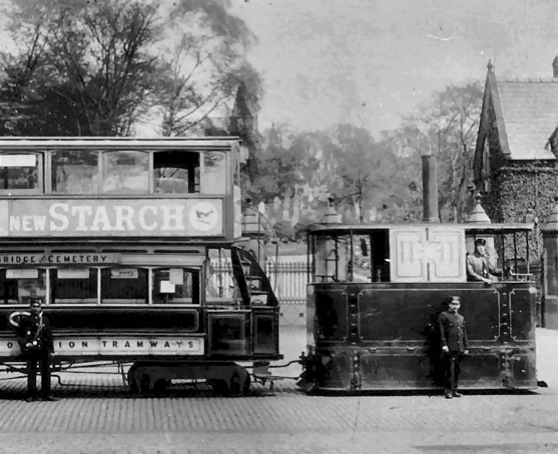
A conductor, an inspector and a driver pose for the camera with an ex-North Staffordshire Tramways Beyer Peacock 'Wilkinson patent' engine (Blackburn No 21) and ex-Blackburn and Over Darwen Tramways Trailer No 18 at the Cemetery terminus in late 1900 or 1901. Both the conductor and the inspector are wearing single-breasted jackets with stand-up collars. Photo courtesy of Jim Halsall.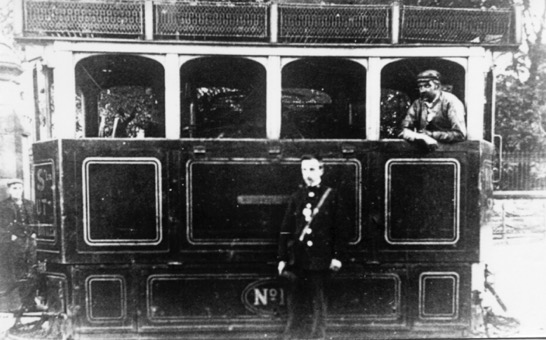
A Blackburn Corporation Tramways conductor poses with Steam Tram No 18 (a loco of uncertain origin — it is not in BCT livery) outside the Cemetery terminus — photo undated, but probably taken in 1900 or 1901. Photo courtesy of Jim Halsall.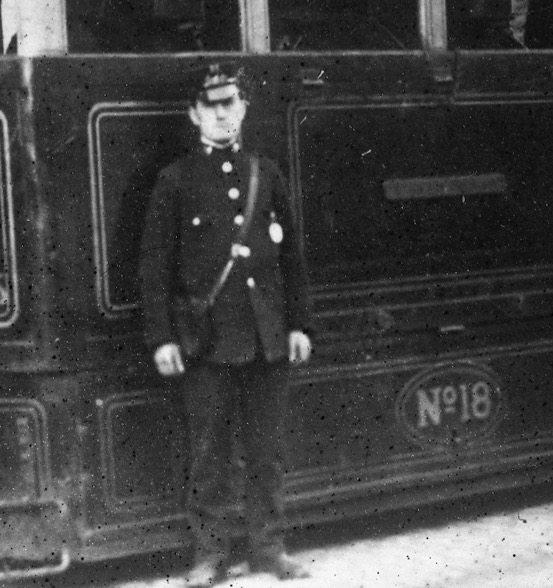
Another shot of the same loco at the same location. The conductor is wearing a drooping-peak cap bearing script-lettering grade badge (almost certainly 'Conductor'), with an employee number above. He is also wearing a licence badge. Photo courtesy of the National Tramway Museum.
Motormen and conductors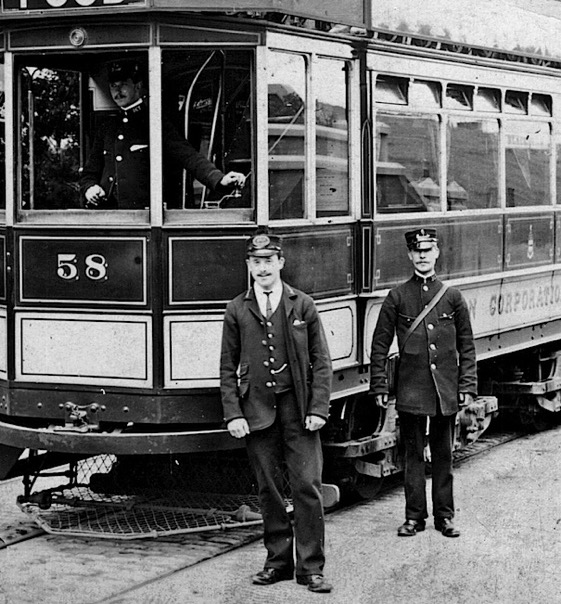
A driver, an inspector (probably) and a conductor pose with Tramcar No 58 at Brownhill around 1901/2. Neither the conductor nor the motorman (called 'drivers' in Blackburn) are wearing a licence badge. Photo courtesy of Duncan Holden.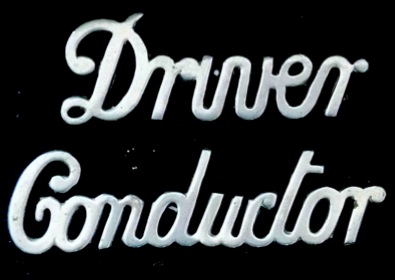
Blackburn Corporation Tramways script-lettering cap badges — nickel. Author's Collection.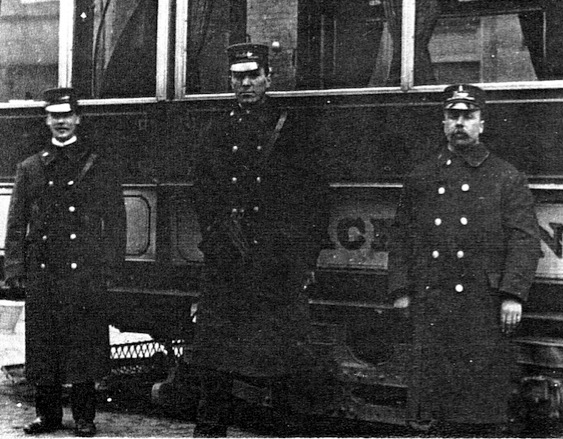
Two conductors and a driver, all in their heavy-duty greatcoats — photo undated, but probably taken in either 1901 or 1902 given the early lifeguard (thanks to Phil Calvey for this information). Photo courtesy of Duncan Holden.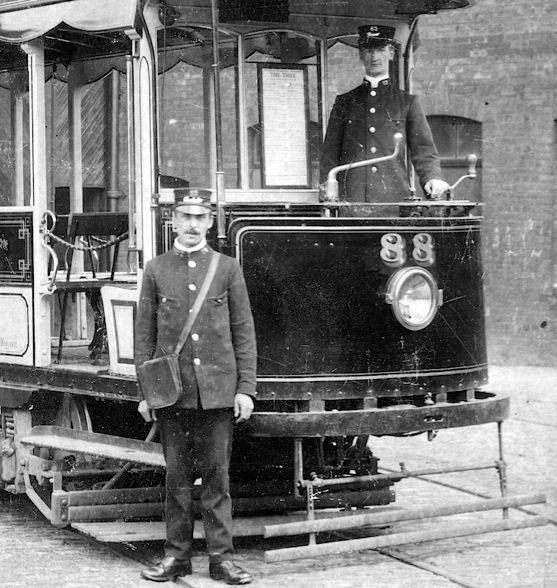
A driver and a motorman pose with what is evidently a brand-new No 88 at Intack depot — photo undated, but probably taken in 1908. Both men are wearing the 'B C T' system initials on their right-hand collars rather than the left-hand side seen in earlier shots. Once again, no licence badges are in evidence. Photo courtesy of the Blackburn Transport Archive Collection (Duncan Holden Collection).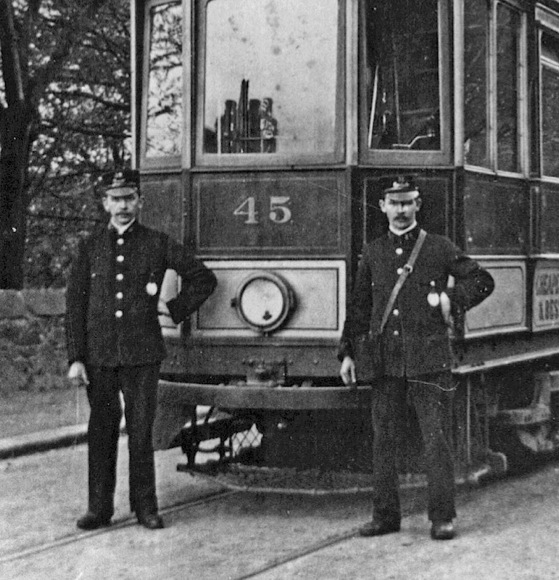
The crew of Tramcar No 45 pose for the camera at Wilpshire around 1910. Both men are wearing licence badges. Photo courtesy of Duncan Holden.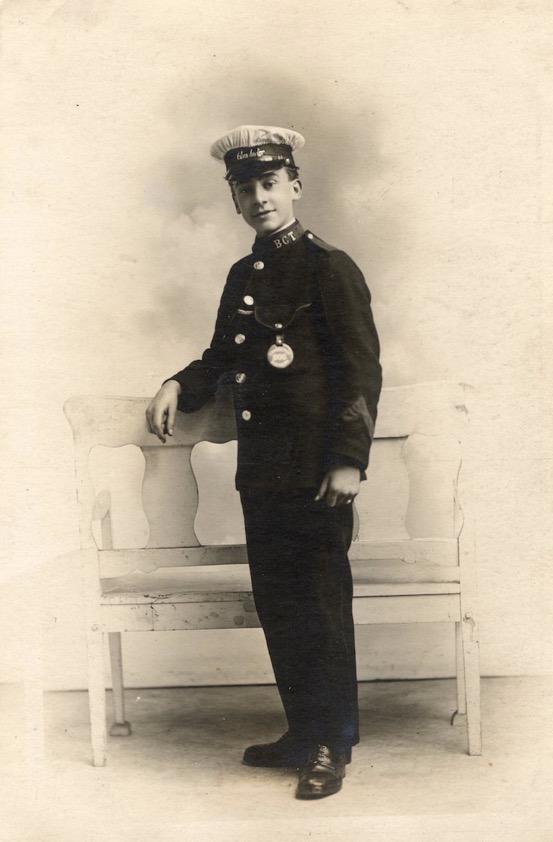
A nice studio portrait of a Blackburn Corporation Tramways conductor — photo undated, but probably taken shortly before the Great War. The photographer was ‘Burton and Garland Ltd, of Blackburn and Blackpool’. The uniform is a new style, with epaulettes, collars and sleeve chevrons in a different colour (light blue) than the main body of the uniform (navy blue). Author's Collection.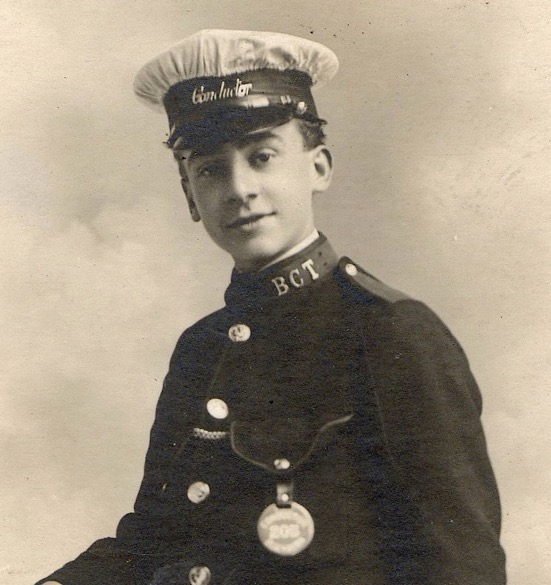
An enlargement of the above photograph showing details of the uniform. The municipal licence badge states: ‘CONDUCTOR 205 BLACKBURN’.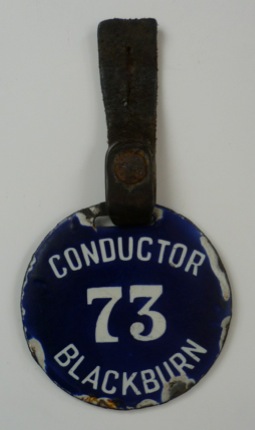
Blackburn Corporation Tramways conductor's licence badge No 73. Author's Collection.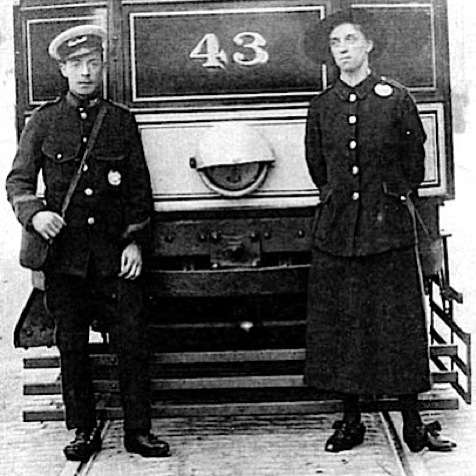
A conductor and a motorwoman pose in front of Tramcar No 43 — photo undated, but almost certainly taken during the Great War. The conductor is wearing the newer style of uniform and cap. Photo: J Halsall Collection. With thanks to Duncan Holden.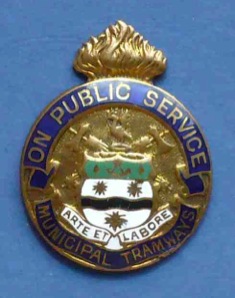
Public service button hole badge. It is unclear what these badges were used for, possibly for non-uniformed staff to wear during the Great War or Second World War. Author's Collection.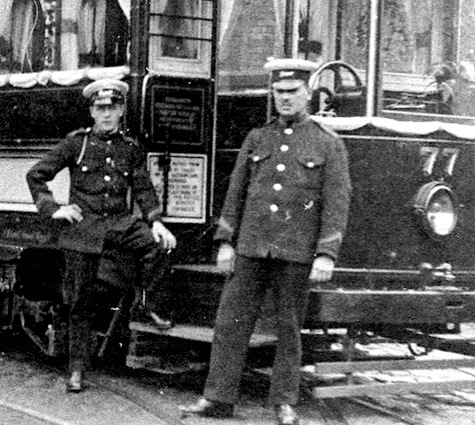
A motorman and a conductor pose with Tramcar No 77 in 1921. With thanks to Duncan Holden.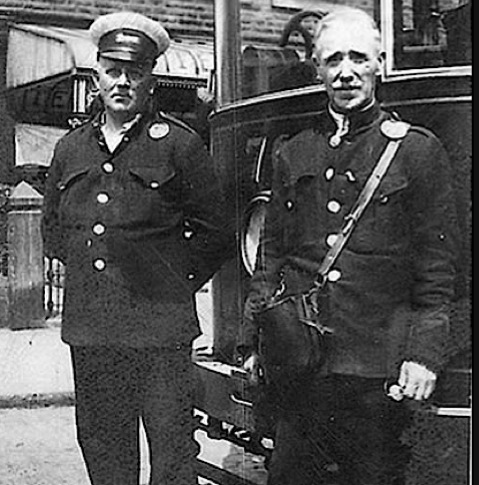
Conductor Robert Pixton (right), together with his motorman, in front of Tramcar No 76 at the Queens Park Terminus — photo undated, but probably taken in the 1920s or early 1930s. Photo courtesy of Brenda Mummery (Pixton Family Collection). With thanks to Duncan Holden.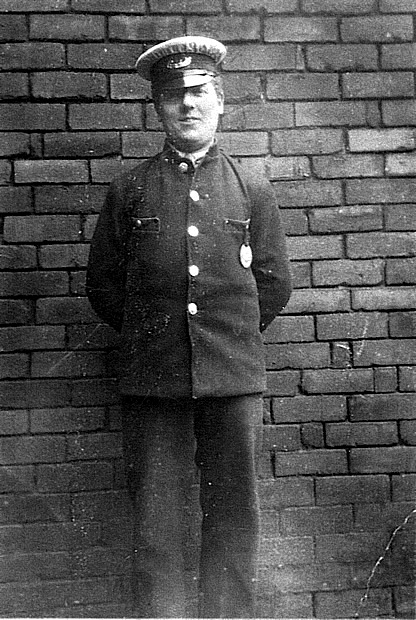
Conductor Theo Moran in 1929 aged 30 years. It is unclear why he is wearing what appears to be a pre-Great War uniform, as this is the only post-1914 photo that shows this older style of uniform. Photo courtesy of Duncan Holden.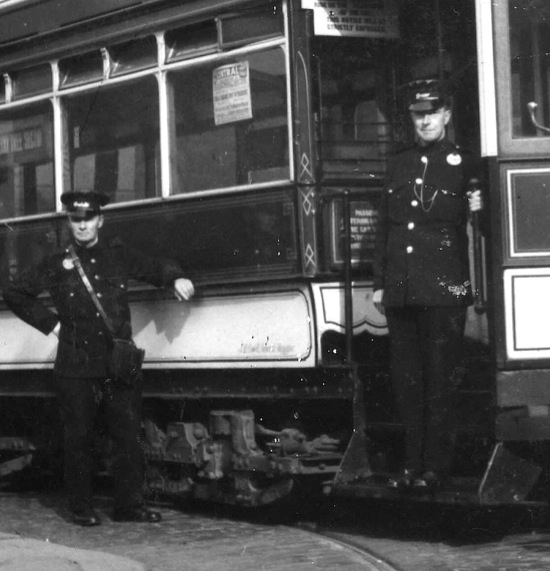
Conductor Ted Bury and Motorman Bob Barker with Tramcar No 75 at Intack in 1933. Both men are wearing black rain covers on their caps; these were worn from the first Sunday in October through to the first Sunday in May. Photo and background information courtesy of Duncan Holden.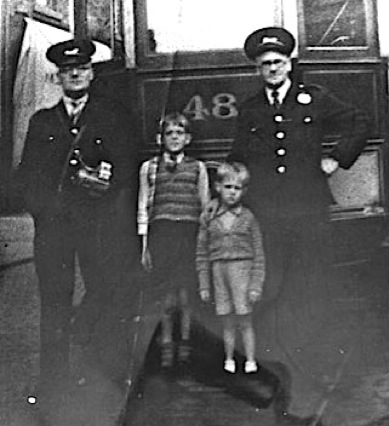
Conductor Theo Moran (left), now aged 50, poses with local children and a motorman in front of Tramcar No 48 at Intack on the last day of service, 3rd September 1949. With thanks to Duncan Holden.
Junior grades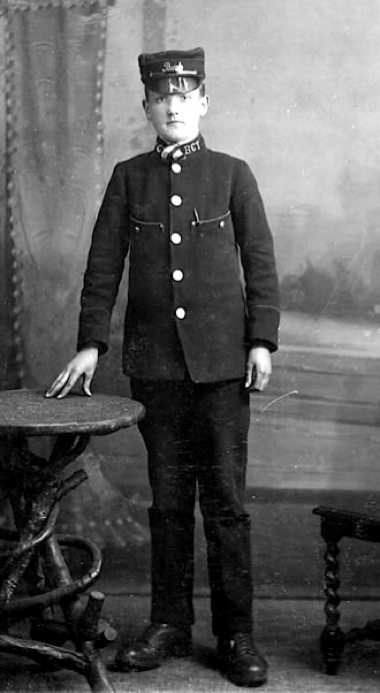
Mr Potts, a BCT parcels boy — photo undated, but probably taken in the first decade of electric operation. Mr Potts eventually went on to become the General Manager in 1938. Photo courtesy of Chris Wilson and the family of Mr Potts. With thanks to Duncan Holden.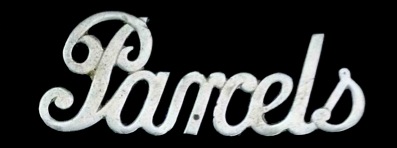
Blackburn Corporation Tramways Parcels script-lettering cap badge — nickel. Author's Collection.
Senior staff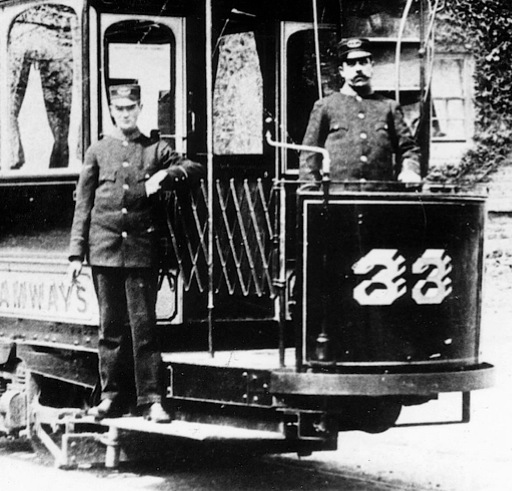
Two staff pose for the cameraman with Tramcar No 33 at Billinge — photo undated, but probably taken in 1899. It is probable that both men are inspectors given that they are wearing large oval cap badges (see below), and all other photos from this era show tramcar crew wearing standard script-lettering badges with employee numbers. Photo courtesy of Duncan Holden.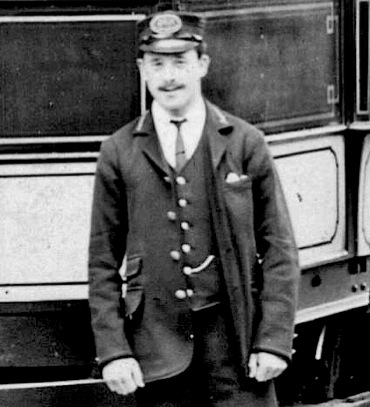
An enlargement of the 1903 photograph taken at Brownhill (see above) showing an inspector in front of Tramcar No 58. By this time, the jackets had lapels, with collars bearing embroidered script lettering, almost certainly 'Inspector'. The large oval cap badge is likely to have been cloth, and probably bore the grade (Inspector) and system initials ('BCT') within a wreath, as this was a fairly common pattern of tramway inspector's badge. Photo courtesy of Duncan Holden.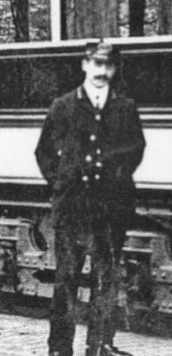
An inspector standing in front of Tramcar No 62 near Redcap around 1906. Photo courtesy of Duncan Holden.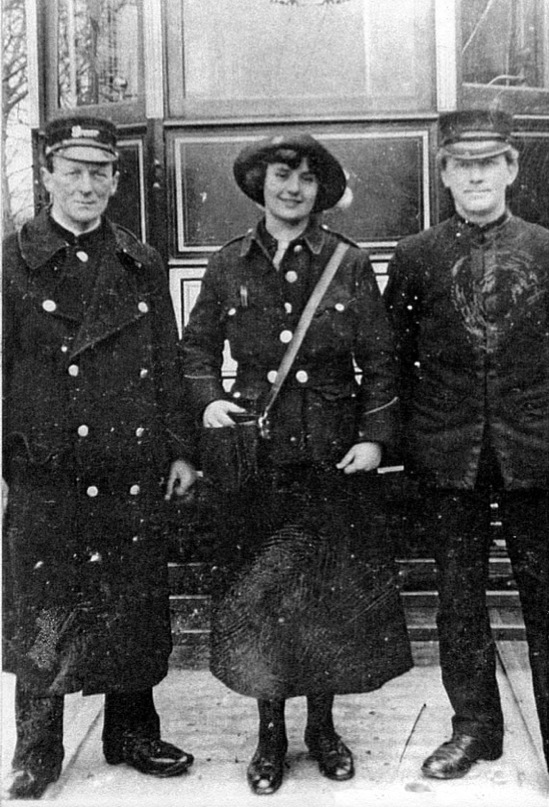
A motorman, a conductress and an inspector at Wilpshire — photograph undated, but certainly taken during the Great War. Photo courtesy of Duncan Holden.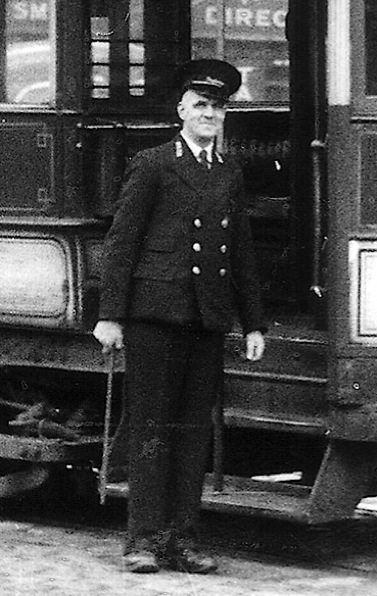
Tramways Inspector Leeming — 18th April 1949. With thanks to Duncan Holden.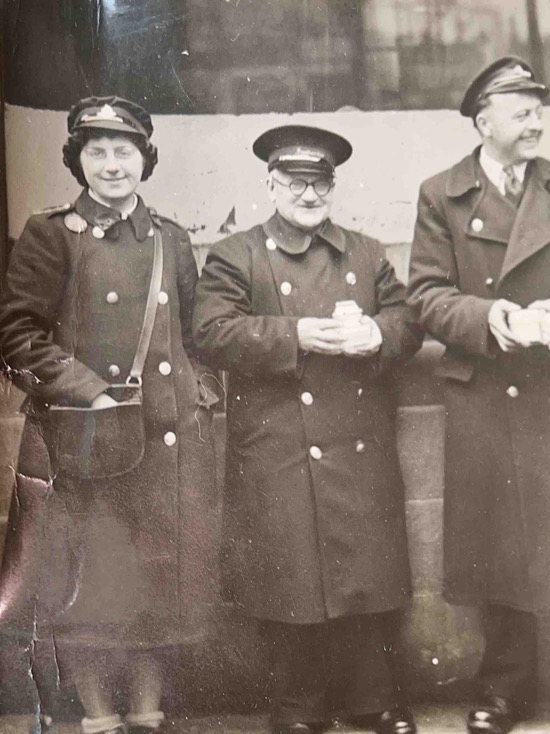
A Blackburn Corporation Transport inspector (centre), flanked by Conductress Edith Bartrupe (nee Lloyd) and a man who was, in all probability, a bus driver. The photograph was probably taken in the late 1940s or early 1950s, so possibly after the demise of the trams. Photo with the kind permission of Julie Fowley, Edith Bartrupe's granddaughter.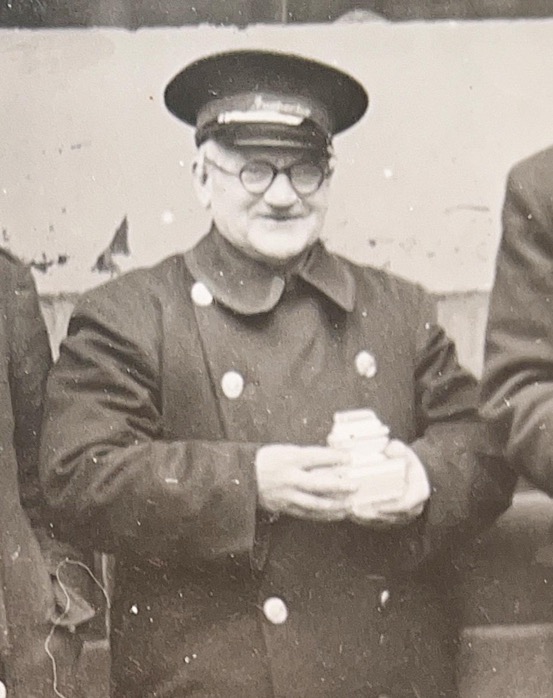
An enlargement of the above photograph showing the inspector. He is wearing a long, double-breasted, lancer-style topcoat (unmarked), and a cap bearing his grade in embroidered script lettering.
Female staff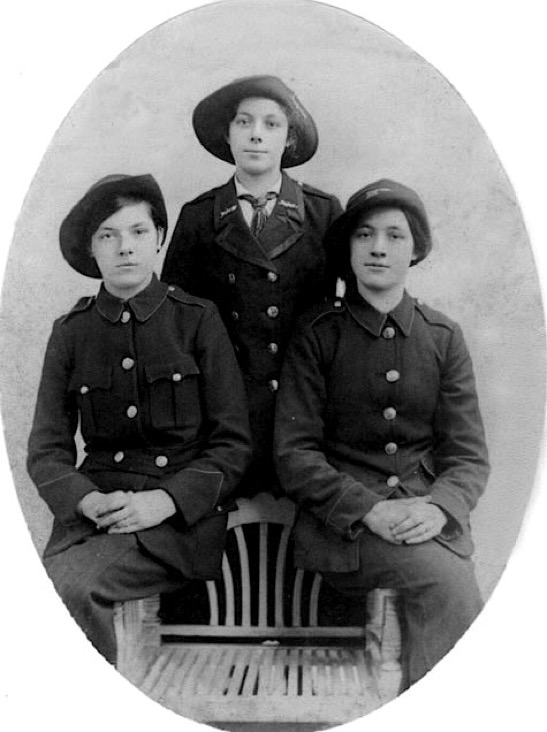
A studio portrait of the Muir sisters: Sarah (a conductress), Mary (an inspectress) and Annie (possibly a motorwoman) — photo undated, but certainly taken in the Great War. Photo: J Halsall Collection. With thanks to Duncan Holden.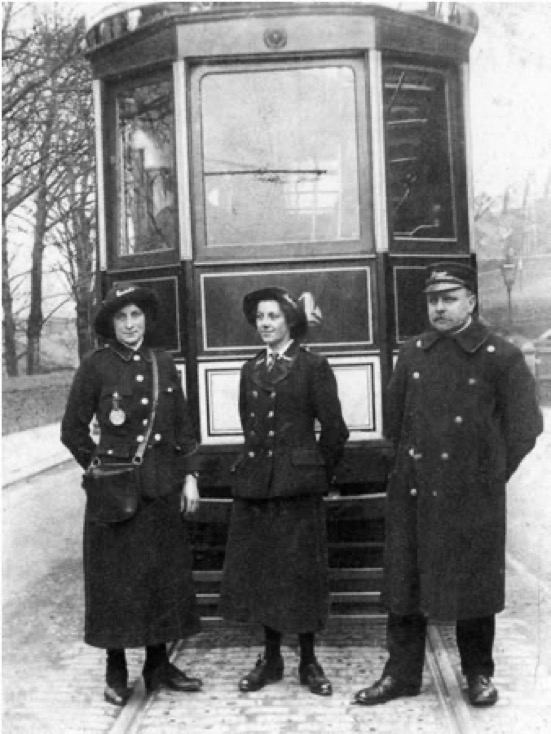
A conductress, an inspectress and a motorman pose at Wilpshire — photo undated, but probably taken during or just after the Great War. The lady on the left is wearing a municipal licence badge, whilst the motorman still has an older drooping-peak cap. Photo: J Halsall Collection. With thanks to Duncan Holden.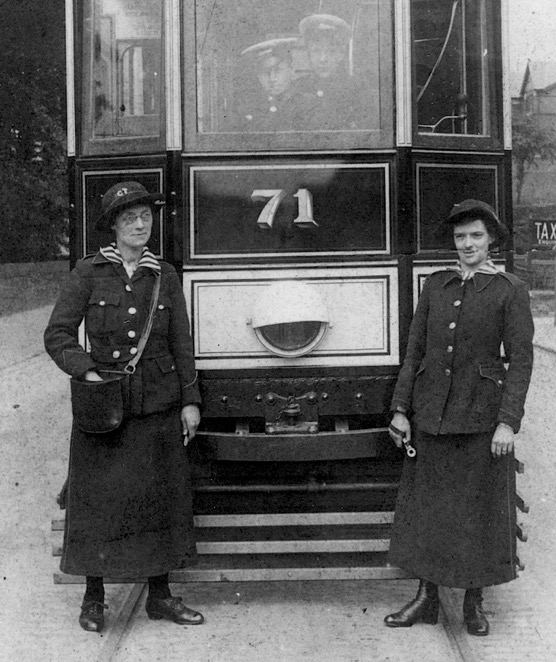
Another Great War shot taken at Wilpshire, this time of Tramcar No 71, with a conductress (left) and a motorwoman (right, with controller handle); the latter is wearing a markedly different pattern of jacket. Both ladies are wearing similar striped blouses, raising the possibility that these were issued by the corporation. Photo: J Halsall Collection. With thanks to Duncan Holden.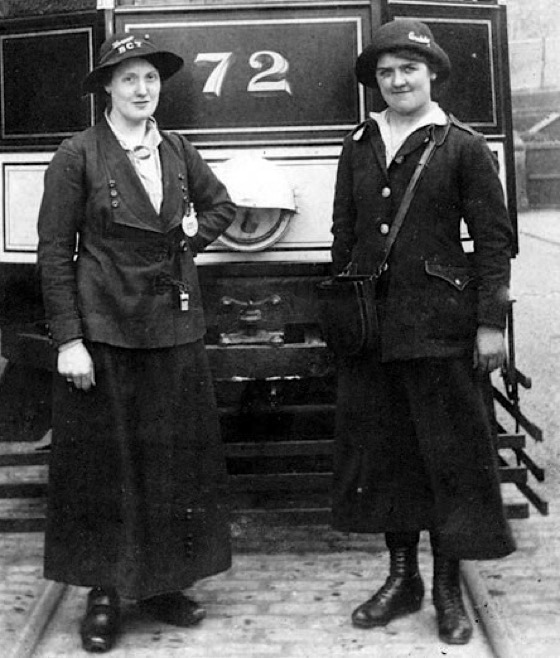
A motorwoman (with non-standard jacket) and a conductress pose in front of Tramcar No 72 at Wilpshire — photo undated, but probably taken during or just after the Great War. The lady on the left is wearing the ‘B C T’ collar initials on her bonnet. Photo: J Halsall Collection. With thanks to Duncan Holden.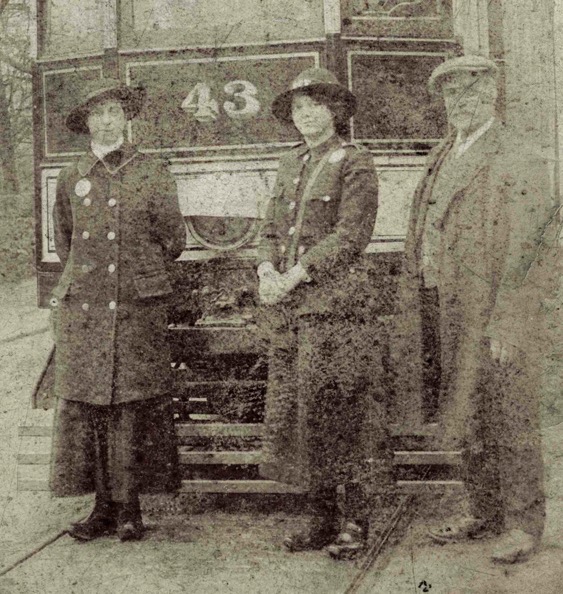
A motorwoman and conductress pose for the camera with Tramcar No 43 at Wilpshire — although the photograph is undated, there is good reason to think that it was taken in Winter 1916/17. The lady in the centre is Edith Knowles, who was born in July 1899, and who applied to join the tramway in September 1916. She would have been 17 years old at the time, so she was probably a little economical with the truth, given that applicants had to be 18 years of age. Edith apparently loathed working in the mills — from whence she came, and where she was destined to return — so tramway conducting would have been an opportunity to escape the drudgery, even if only for a few years. With thanks to Gail Everett, Edith Knowles grand-daughter, for permission to use the photograph, and for the biographical information.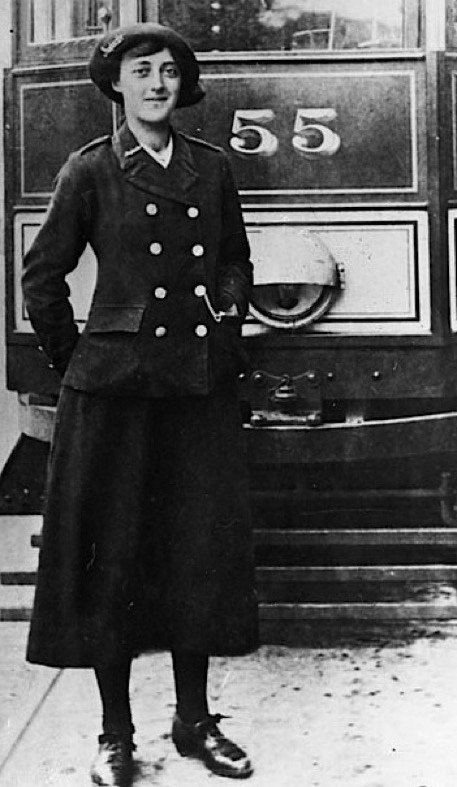
An inspectress poses in front of Tramcar No 55 — photo undated, but almost certainly taken during the Great War. The 'Inspector' script-lettering cap badge on the bonnet is easily made out. Photo: J Halsall Collection. With thanks to Duncan Holden.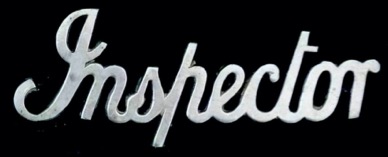
Blackburn Corporation Tramways 'Inspector' script-lettering cap badge, as worn by inspectresses during the Great War — nickel. Author's Collection.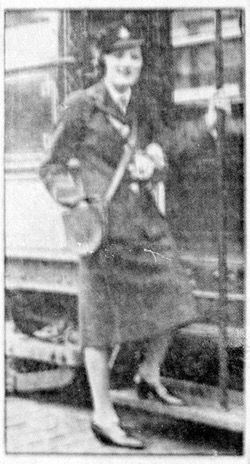
The only known photograph of a Second World War-era BCT tram conductress — photo undated, but certainly taken during, or shortly after, the Second World War. Although of very poor quality indeed, it does show the distinctively shaped municipal-device badge worn by conductresses on their motor caps. Photo courtesy of Duncan Holden.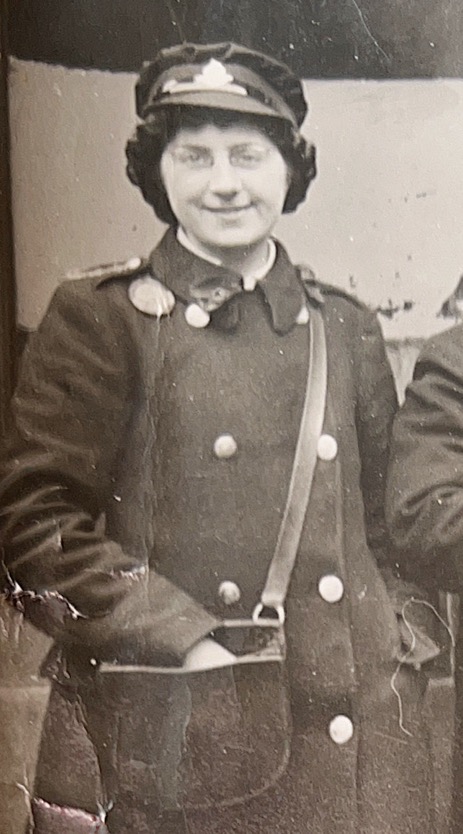
A photograph of Conductress Edith Bartrupe (nee Lloyd). which in view of the PSV licence badge below her topcoat epaulette (left side of the photo), was probably taken when she was working as a BCT bus conductress in the late 1940s or early 1950s. The epaulette bears a script-lettering grade badge, 'Conductor', her motor cap a Blackburn municipal-device badge. Edith Lloyd was born on the 3rd May 1923, and joined the tramway in the Second World War (aged 17 or 18 years), staying for fourteen years in total, and eventually moving onto bus conducting. She married bus conductor Bob Bartrupe (subsequently promoted to Ticket Inspector, and eventually to Traffic Inspector); she died aged 90 years in 2013. Photo courtesy of Edith's granddaughter, Julie Fowley.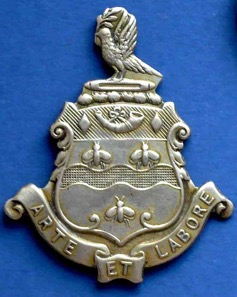
Blackburn municipal-device cap badge — nickel. This badge was used on conductresses' motor caps, both tram and bus staff, though curiously, seemingly not on the caps of male tramcar staff. Author's Collection.
Uniform costs
Information has fortunately survived on the cost of Blackburn uniforms, and I am indebted to Duncan Holden for making me aware of the following.
In September 1916, a three-year contract was awarded to Briggs, Jones and Gibson Limited for the supply of uniforms. The first order was for £17. 8s. 6d., followed by further orders in October for £34.19s. 6d., November for £10.16s. 4d., December for £50.19s. 5d., and in January 1917 for £34. 1s.11d. Costs were as follows:
Motormen and conductors Tunics..................27s. 6d.
Trousers........................................................16s. 0d.
Overcoats......................................................32s. 6d.
Caps................................................................3s. 9d.
Conductresses Costumes...............................52s. 6d.
Overcoats......................................................32s. 6d.
Gaiters............................................................3s.11d.
Serge hats.......................................................3s. 9d.
A comparison was subsequently made (in 1918) with the prices that Oldham Corporation had recently paid (in August 1917); this was presumably conducted to demonstrate the savings resulting from the contract.
